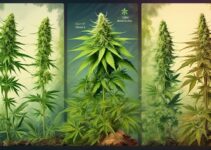When it comes to selecting cannabis seeds that can withstand drought conditions, the choices may seem overwhelming, but the right genetics can make all the difference. You may find yourself wondering which strains will thrive with minimal water and still produce high-quality yields. Well, look no further because in this discussion, you'll uncover the key characteristics and factors that make certain cannabis seeds resilient to drought. By the end, you'll have a clear understanding of the best options available and be ready to make informed decisions for your growing needs.
Key Takeaways
- Drought-resilient cannabis seeds possess characteristics such as deep taproots, taller and skinnier plant structures, and reduced leaf surface area, which help them access water reserves and minimize water loss.
- Drought-tolerant genetics are essential as they mitigate water scarcity, enhance resilience to drought, require less water, and tolerate excessive heat, contributing to sustainable cultivation practices.
- Genetic benefits of drought-resilient seeds include increased resilience to drought conditions, strong taproots for accessing deeper water, efficient water use under different conditions, and less water usage in hot and dry climates.
- Drought-resilient seeds promote water conservation by thriving in hot, dry, and arid conditions, requiring less water, tolerating excessive heat, reducing water usage compared to clones, and offering genetic innovation for sustainability.
Characteristics of Drought-Resilient Cannabis Seeds
Drought-resilient cannabis seeds exhibit physical characteristics such as a deep taproot and taller, skinnier plant structure, allowing them to tolerate low moisture levels without wilting. These traits enable the plants to thrive in hot and dry climates, making them ideal strains to cope with dry conditions. The deep taproot serves as an anchor, reaching deep into the soil to access water reserves that are beyond the reach of shallower roots. This adaptation allows the plant to withstand extended periods of drought by tapping into subsoil moisture. The taller, skinnier plant structure also aids in drought resistance by minimizing water loss through evapotranspiration. Additionally, these plants have a reduced leaf surface area, which helps conserve water during periods of low moisture. These physical characteristics are essential for cannabis plants to survive and thrive in arid environments. Understanding these traits is crucial for selecting suitable cannabis strains for cultivation in regions prone to drought and limited water availability.
Importance of Drought-Tolerant Genetics
You should consider the genetic benefits of drought-tolerant cannabis strains for water conservation. These genetics exhibit higher vigor and can thrive with less water, making them crucial for cultivation in arid conditions. By selecting these resilient genetics, growers can mitigate the impact of water scarcity and high temperatures on their cannabis crops.
Genetic Benefits
Genetic benefits play a crucial role in the development of drought-tolerant cannabis strains, as high-vigor genetics have been observed to exhibit increased resilience to drought conditions, thereby reducing the water requirements for cultivation. In dry weather or hot climates, the genetic benefits of drought-tolerant cannabis seeds become apparent. These genetics enable plants to establish a strong taproot, allowing them to draw up water from deeper layers of the soil, thus enhancing their ability to withstand drought conditions. Additionally, certain hemp genetics have been found to have a more efficient pattern of water use under different conditions. Despite water usage not being a significant cost driver in the cannabis industry, prioritizing genetics that use less water can contribute to sustainable cultivation practices, especially in hot and dry climates.
Water Conservation
In the context of water conservation, the genetic benefits observed in drought-tolerant cannabis strains play a crucial role in mitigating water scarcity and enhancing resilience to drought conditions. Drought-resistant strains can thrive in hot, dry, and arid conditions, requiring less water and tolerating excessive heat. When considering water conservation, planting directly from drought-resilient cannabis seeds or seedlings can significantly reduce water usage compared to planting clones, as they establish strong taproots. It's important to note that different hemp genetics exhibit varying levels of drought tolerance and water use efficiency. Balancing water conservation and yield in cannabis cultivation involves prioritizing weight and cannabinoid production, water recycling, and genetic resilience to water stress. It's essential for cannabis growers to consider water conservation and sustainability, with genetic innovation around drought-resistant strains becoming increasingly prevalent in the future.
| Importance of Drought-Tolerant Genetics | Benefits |
|---|---|
| Less water usage | Mitigates water scarcity |
| Tolerates excessive heat | Enhances resilience to drought |
| Strong taproots | Reduced water requirement |
| Varying drought tolerance | Genetic innovation for sustainability |
Key Factors in Selecting Drought-Resilient Seeds
When selecting drought-resilient cannabis seeds, it is essential to consider specific seed selection criteria, including genetic traits that promote water efficiency and adaptation to arid conditions. Look for genetics with high vigor, as they are often more drought-resistant and require less water. Additionally, consider strains developed specifically to tolerate excessive heat and require reduced watering, as well as autoflowering varieties that have a shorter growing season and can be harvested before early freezes or wildfires.
Seed Selection Criteria
To select drought-resilient cannabis seeds, prioritize those with genetics exhibiting high vigor as they often demonstrate increased drought resistance and reduced water requirements. When selecting strains, look for those with a strong taproot that can draw water from deeper soil layers. Consider strains developed to tolerate excessive heat and require reduced watering, such as those from California-based seed company Atlas Seeds. Additionally, autoflowering strains offer a shorter growing season, making them suitable for drought-prone areas as they can be harvested before early freezes or wildfires. With the potential for water scarcity, more growers may seek plants requiring less water and resistant to high temperatures. Careful consideration of these factors can help ensure successful cultivation of cannabis in dry and heat-stressed outdoor environments.
Water Efficiency Traits
Selecting drought-resilient cannabis seeds involves identifying water efficiency traits that are crucial for successful cultivation in dry and heat-stressed outdoor environments, such as genetics displaying high vigor, strong taproots, and tolerance to excessive heat and reduced watering requirements. When considering water efficiency traits for cannabis seeds, look for genetics that exhibit high vigor, as these are often more drought-resistant and require less water. Additionally, prioritize strains that can tolerate excessive heat and require reduced watering, as these are essential for cultivation in hot climates. Furthermore, prioritize seeds that establish a strong taproot, enabling the plant to draw up water from deeper layers of the soil. These traits are vital for growing cannabis in drought-resilient conditions, ensuring optimal yield and sustainability in water-scarce environments.
Adaptation to Arid Conditions
Adopting drought-resilient cannabis seeds involves identifying key factors that contribute to their adaptation to arid conditions, such as genetic traits that prioritize high vigor, strong taproots, and reduced water requirements. These traits enable the plants to withstand prolonged dry spells and high temperatures. Selecting seeds or seedlings with strong taproots allows for better soil penetration and the ability to draw up water from deeper layers, mitigating the effects of water scarcity. Hemp genetics exhibit varying levels of drought tolerance and water use efficiency, providing options for growers to choose strains that are better suited to arid conditions. As the future of cannabis cultivation trends towards sustainable practices, genetics that require less water and are more resistant to drought and high temperatures are becoming increasingly important for ensuring successful yields in water-limited environments.
Best Drought-Tolerant Cannabis Seeds for Outdoor Growing
Consider choosing cannabis seeds with genetics that exhibit high vigor and drought resistance for successful outdoor growing in arid conditions. When selecting drought-tolerant cannabis seeds for outdoor cultivation, it's essential to prioritize genetic traits that can thrive in hot and dry environments. Look for seeds that are specifically bred for outdoor growing and are known for their ability to withstand drought conditions. Additionally, consider autoflowering strains, which have a shorter growing season and can be harvested before early season freezes or wildfires. When choosing seeds, prioritize those that establish a strong taproot, as this helps draw up water from deeper layers of the soil, essential for outdoor cultivation in drought-prone areas. Moreover, certain hemp cultivars have a more efficient pattern of water use under different conditions and may be suitable for outdoor growing in arid regions. Finally, consider genetics that not only use less water but also prioritize weight and cannabinoid production, ensuring a successful outdoor cannabis cultivation despite challenging environmental conditions.
Top Drought-Resistant Cannabis Strains for Indoor Cultivation
When cultivating cannabis indoors, prioritize drought-resistant strains with genetics that exhibit high vigor and water use efficiency to ensure successful growth in controlled environments. Top drought-resistant cannabis strains for indoor cultivation include those with traits that enable them to thrive in reduced water conditions. Autoflowering cannabis strains, such as Northern Lights Auto and Blue Mystic Auto, are excellent choices for indoor cultivation due to their ability to complete their life cycle quickly, reducing water requirements. These strains also exhibit resilience to heat stress, making them suitable for indoor environments where temperature control is crucial. Additionally, the Durban Poison and Amnesia Haze strains are known for their drought resistance and adaptability to indoor growing conditions. Their genetics allow for efficient use of water, making them valuable assets for indoor cultivation. By selecting these top drought-resistant cannabis strains for indoor cultivation, you can optimize water usage and ensure successful growth in controlled environments while maintaining high-quality yields.
Tips for Breeding Drought-Resilient Cannabis Varieties
To develop drought-resilient cannabis varieties, focus on breeding strains with genetics that exhibit high vigor and water use efficiency, building on the foundation of selecting top drought-resistant cannabis strains for indoor cultivation. Here are some tips for breeding drought-resilient cannabis varieties:
- Selecting Genetics with High Vigor:
- Choose strains with inherent vigor, as these are often more resilient to drought conditions and require less water to thrive.
- Emphasizing Shorter Growing Seasons:
- Consider breeding autoflowering strains, which have a shorter growing season and can be harvested before early season freezes or wildfires, making them suitable for drought-prone areas.
Breeding drought-resilient cannabis varieties entails a scientific and technical approach. It involves understanding the genetic traits that contribute to water use efficiency and drought resistance. Additionally, considering the environmental factors, such as water availability and temperature, is crucial. Breeding for drought-resilience requires a comprehensive understanding of the genetic diversity within cannabis and how different strains can tolerate and adapt to varying levels of water scarcity. By implementing these breeding strategies, you can develop cannabis varieties that are well-suited for growing in hot and dry climates, ultimately contributing to sustainable and resilient cultivation practices.
The Future of Drought-Resistant Cannabis Genetics
The future of drought-resistant cannabis genetics holds promising advancements in optimizing water use efficiency and developing genetic traits that enhance resilience to water scarcity and environmental stressors. Cannabis growers are increasingly seeking drought-resistant cannabis seeds to mitigate water scarcity and adapt to changing environmental conditions. The cannabis industry is witnessing a surge in research and innovation focused on developing cannabis genetics that can thrive in arid climates and withstand water stress.
| Advancements in Drought-Resistant Cannabis Genetics | Emotions Evoked |
|---|---|
| Optimize water use efficiency | Hopeful |
| Develop genetic traits for resilience to water scarcity | Encouraged |
| Adapt to changing environmental conditions | Determined |
| Mitigate water scarcity | Committed |
In this quest, autoflower cannabis strains with shorter grow seasons are gaining attention for their potential to conserve water and provide a sustainable option for cannabis cultivation. Additionally, ongoing research into hemp genetics is essential for understanding and optimizing drought tolerance and water use efficiency in different production environments. As the industry embraces water conservation and sustainability, genetic innovation for drought-resistant cannabis strains is expected to accelerate, offering a promising future for cannabis growers seeking resilient and water-efficient cannabis strains.
Frequently Asked Questions
What Are the Best Cannabis Seeds for 2023?
For 2023, you'll want to consider top strains for maximum yield potential. Growing techniques and climate adaptability are crucial factors. Seed banks with a focus on drought-resilient genetics could offer the best options.
What Is the Most Stable Cannabis Genetics?
When seeking the most stable cannabis genetics, consider top hybrid strains for balanced effects. Assess the benefits of autoflowering, high THC content, and Indica vs. Sativa traits. For outdoor vs. indoor growing, prioritize drought-resilient varieties.
What Is the Best Cannabis Seed to Grow?
For the best cannabis seeds to grow, consider soil requirements, outdoor vs. indoor suitability, pest resistance, THC levels, and yield potential. Choose strains with high vigor, drought tolerance, and reduced water needs.
What Is the Fastest Seed to Harvest Cannabis Strain?
For a fast harvest, seek early flowering, rapid growth, and speedy maturation in cannabis strains. Look for genetics with quick yield to optimize your growing season. These traits can lead to a bountiful and efficient harvest.





